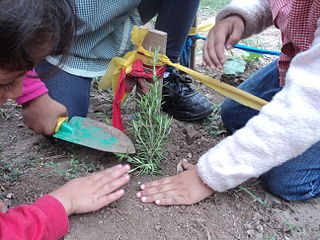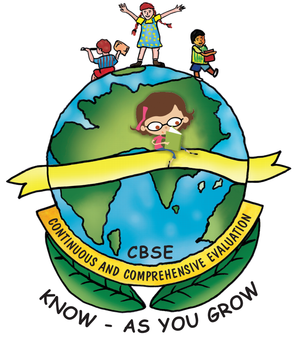Educational psychology is the branch of psychology concerned with the scientific study of human learning. The study of learning processes, from both cognitive and behavioral perspectives, allows researchers to understand individual differences in intelligence, cognitive development, affect, motivation, self-regulation, and self-concept, as well as their role in learning. The field of educational psychology relies heavily on quantitative methods, including testing and measurement, to enhance educational activities related to instructional design, classroom management, and assessment, which serve to facilitate learning processes in various educational settings across the lifespan.

Training is teaching, or developing in oneself or others, any skills and knowledge or fitness that relate to specific useful competencies. Training has specific goals of improving one's capability, capacity, productivity and performance. It forms the core of apprenticeships and provides the backbone of content at institutes of technology. In addition to the basic training required for a trade, occupation or profession, training may continue beyond initial competence to maintain, upgrade and update skills throughout working life. People within some professions and occupations may refer to this sort of training as professional development. Training also refers to the development of physical fitness related to a specific competence, such as sport, martial arts, military applications and some other occupations.

Fiorello H. LaGuardia High School of Music & Art and Performing Arts, often referred to simply as LaGuardia, is a public high school specializing in teaching visual arts and performing arts, located near Lincoln Center in the Lincoln Square neighborhood of the Upper West Side in Manhattan, New York City. Located at 100 Amsterdam Avenue between West 64th and 65th Streets, the school is operated by the New York City Department of Education, and resulted from the merger of the High School of Music & Art and the School of Performing Arts. The school has a dual mission of arts and academics, preparing students for a career in the arts or conservatory study as well as a pursuit of higher education.
Gifted education is a sort of education used for children who have been identified as gifted and talented.
Educational assessment or educational evaluation is the systematic process of documenting and using empirical data on the knowledge, skill, attitudes, aptitude and beliefs to refine programs and improve student learning. Assessment data can be obtained from directly examining student work to assess the achievement of learning outcomes or can be based on data from which one can make inferences about learning. Assessment is often used interchangeably with test, but not limited to tests. Assessment can focus on the individual learner, the learning community, a course, an academic program, the institution, or the educational system as a whole. The word 'assessment' came into use in an educational context after the Second World War.
When children are young, schools begin to analyze the youngsters’ abilities and sort them into clusters based on their predicted success. The system labels the cream of the crop as gifted. Clark (2002) defines giftedness as “only a label that society gives to those who have actualized their ability to an unusually high degree or give evidence that such achievement is imminent”. The American government defines giftedness as “students, children or youth who give evidence of high performance capability in areas such as intellectual, creative, artistic, or leadership capacity, or in specific academic fields, and who require services or activities not ordinarily provided by the school in order to fully develop such capabilities”. Gifted students learn in a different manner and at an accelerated rate compared to their peers in the classroom and therefore require gifted programs to develop and apply their talents.
The Washington Assessment of Student Learning (WASL) was a standardized educational assessment system given as the primary assessment in the state of Washington from spring 1997 to summer 2009. The WASL was also used as a high school graduation examination beginning in the spring of 2006 and ending in 2009. It has been replaced by the High School Proficiency Exam (HSPE), the Measurements of Students Progress (MSP) for grades 3–8, and later the Smarter Balanced Assessment (SBAC). The WASL assessment consisted of examinations over four subjects with four different types of questions. It was given to students from third through eighth grades and tenth grade. Third and sixth graders were tested in reading and math; fourth and seventh graders in math, reading and writing. Fifth and eighth graders were tested in reading, math and science. The high school assessment, given during a student's tenth grade year, contained all four subjects.

Music education is a field of practice in which educators are trained for careers as elementary or secondary music teachers, school or music conservatory ensemble directors. Music education is also a research area in which scholars do original research on ways of teaching and learning music. Music education scholars publish their findings in peer-reviewed journals, and teach undergraduate and graduate education students at university education or music schools, who are training to become music teachers.

Visual arts education is the area of learning that is based upon the kind of art that one can see, visual arts—drawing, painting, sculpture, printmaking, and design in jewelry, pottery, weaving, fabrics, etc. and design applied to more practical fields such as commercial graphics and home furnishings. Contemporary topics include photography, video, film, design, and computer art. Art education may focus on students creating art, on learning to criticize or appreciate art, or some combination of the two.
Education in the performing arts is a key part of many primary and secondary education curricula and is also available as a specialisation at the tertiary level. The performing arts, which include, but are not limited to dance, music and theatre, are key elements of culture and engage participants at a number of levels.

The Avery Coonley School (ACS), commonly called Avery Coonley, is an independent, coeducational day school serving academically gifted students in preschool through eighth grade (approximately ages 3 to 14), and is located in Downers Grove, DuPage County, Illinois. The school was founded in 1906 to promote the progressive educational theories developed by John Dewey and other turn-of-the-20th-century philosophers, and was a nationally recognized model for progressive education well into the 1940s. From 1943 to 1965, Avery Coonley was part of the National College of Education (now National Louis University), serving as a living laboratory for teacher training and educational research. In the 1960s, ACS became a regional research center and a leadership hub for independent schools, and began to focus on the education of the gifted.
Eklavya is an Indian NGO based in Bhopal, Madhya Pradesh working in the field of education. It was registered as an all India in 1982. The organization is named after Eklavya, the protagonist of a story in the Mahabharat, for his determination to learn even in the absence of a teacher.
Arts integration differs from traditional education by its inclusion of both the arts discipline and a traditional subject as part of learning The goal of arts integration is to increase knowledge of a general subject area while concurrently fostering a greater understanding and appreciation of the fine and performing arts. The John F. Kennedy Center for the Performing Arts defines arts integration as "an approach to teaching in which students construct and demonstrate understanding through an art form. Students engage in a creative process which connects an art form and another subject and meets evolving objectives in both."

Art Education in the United States refers to the practice of teaching art in American public schools. Before the democratization of education, particularly as promoted by educational philosopher John Dewey, apprenticeship was the traditional route for attaining an education in art. Alongside John Dewey, Elliot Eisner was a leading advocate for the inclusion of art in modern curriculum. Since the first introduction of art in public schooling in 1821, art education in the United States has faced many changes and many stages of growth.

Garden-based learning (GBL) encompasses programs, activities and projects in which the garden is the foundation for integrated learning, in and across disciplines, through active, engaging, real-world experiences that have personal meaning for children, youth, adults and communities in an informal outside learning setting. Garden-based learning is an instructional strategy that utilizes the garden as a teaching tool.
Chicago High School for the Arts (ChiArts) is a public four–year college preparatory visual and performing arts high school located in the Humboldt Park neighborhood in Chicago, Illinois, United States. Operated by the Chicago Public Schools district, The school opened for the 2009–10 school year.
Mount Erin Secondary College is a secondary school located in the suburb of Frankston, Victoria, Australia. It has approximately 930 students and is the only school running the SEAL program in the area. Other schools that run the program include Lyndale Secondary College and Wellington Secondary College.

Continuous and Comprehensive Evaluation (CCE) was a process of assessment, mandated by the Right to Education Act, of India in 2009. This approach to assessment was introduced by state governments in India, as well as by the Central Board of Secondary Education in India, for students of sixth to tenth grades and twelfth in some schools. It was intended to provide students with practice from a young age for the board exams. In 2017, the CCE system was cancelled for students appearing in the Class 10 Board Exam for 2017-18, bringing back compulsory Annual Board Exam and removing the Formative and Summative Assessments under the Remodeled Assessment Pattern.
Modern elementary mathematics is the theory and practice of teaching elementary mathematics according to contemporary research and thinking about learning. This can include pedagogical ideas, mathematics education research frameworks, and curricular material.

Victor D'Amico was an American teaching artist and the founding Director of the Department of Education of the Museum of Modern Art, New York. D’Amico explored the essence of the art experience as spiritual involvement, and the ability to communicate one's most profound ideas and emotions through aesthetic expression. He considered that the individual's personality had to be respected and developed by providing opportunities for creative experimentation. D'Amico's philosophy was based on the fundamental faith in the creative potential in every man, woman and child. He believed "that the arts are a humanizing force and their major function is to vitalize the living."